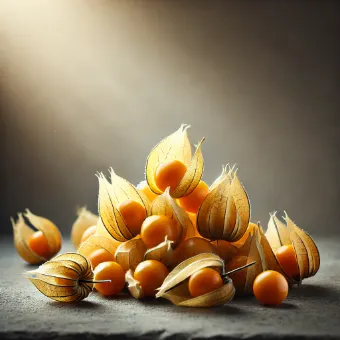Golden Berries: Tangy Tropic Pop with 53 kcal, 11 mg Vitamin C & 5 g Fiber per 100 g
Also called cape gooseberry or Inca berry, these sun-gold globes burst with sweet-sour flavour plus carotenoids and withanolide antioxidants.

What Are Golden Berries?
Fruits of **_Physalis peruviana_**, wrapped in a papery husk. Native to the Andes but now grown from South Africa to California.
Nutrition (100 g fresh)
|Calories|Carbs|Fiber|Protein|Fat|Vitamin C|
|---|---|---|---|---|---|
|53 kcal|11.2 g|4.9 g|1.9 g|0.7 g|11 mg (12 %)|
Benefits
- **Withanolides & carotenoids** act as antioxidants and mild anti-inflammatories.
- 5 g soluble + insoluble **fiber** supports satiety & gut health.
- Lower sugar than raisins—great for diabetic-friendly trail mixes.
Drawbacks
- Unripe, green berries contain solanine—eat only ripe golden fruit.
- Sticky surface can glue dried berries together; dust with cocoa or coconut if baking.
- Acidic bite may bother sensitive stomachs in large portions.
Flavour & Texture
**Tart-sweet burst mixing pineapple, tomato & citrus**; pulp is juicy, seeds add pleasant crunch.
Culinary Uses & Storage
- Toss fresh halves into **quinoa salad, salsa or yogurt bowls**.
- Simmer with chilli for chutney; whirl dried berries into energy bites.
- Store husked berries 2 weeks at 4 °C; dehydrated berries jarred, cool & dark 12 months.
- 1. Golden Berries

